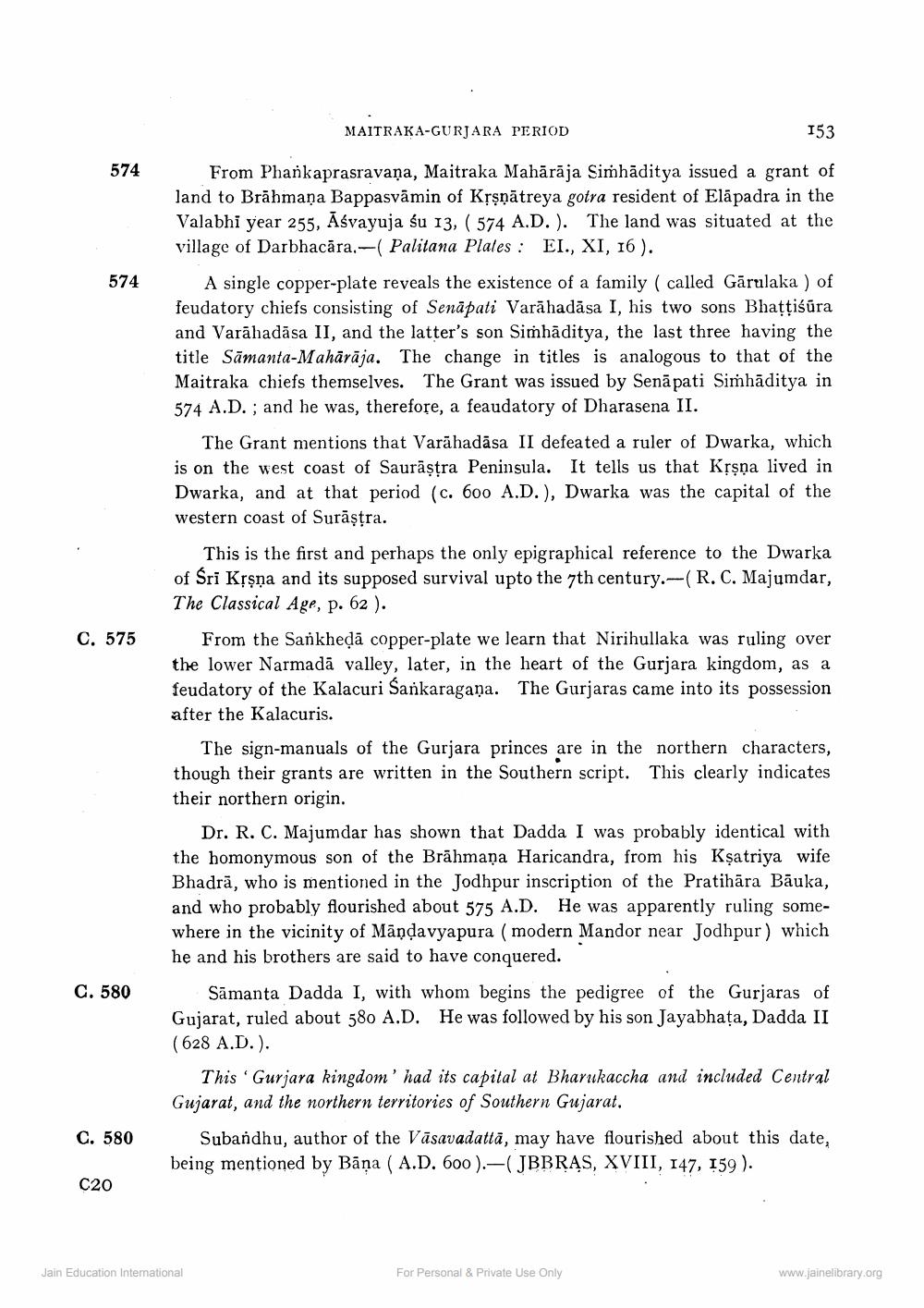________________
MAITRAKA-GURJARA PERIOD
153
574
574
From Phankaprasravana, Maitraka Mahārāja Simhāditya issued a grant of land to Brāhmaṇa Bappasvāmin of Krşņātreya gotra resident of Elāpadra in the Valabhi year 255, Āśvayuja śu 13, ( 574 A.D.). The land was situated at the village of Darbhacāra.-( Palitana Plates : EI., XI, 16).
A single copper-plate reveals the existence of a family ( called Gārulaka ) of feudatory chiefs consisting of Senapati Varāhadāsa I, his two sons Bhattiśūra and Varāhadāsa II, and the latter's son Simhāditya, the last three having the title Sāmanta-Mahārāja. The change in titles is analogous to that of the Maitraka chiefs themselves. The Grant was issued by Senāpati Simhāditya in 574 A.D.; and he was, therefore, a feaudatory of Dharasena II.
The Grant mentions that Varāhadāsa II defeated a ruler of Dwarka, which is on the west coast of Saurāșțra Peninsula. It tells us that Krşņa lived in Dwarka, and at that period (c. 600 A.D.), Dwarka was the capital of the western coast of Surāṣtra.
C. 575
This is the first and perhaps the only epigraphical reference to the Dwarka of Sri Krsna and its supposed survival upto the 7th century.-(R. C. Majumdar, The Classical Age, p. 62 ).
From the Sankheda copper-plate we learn that Nirihullaka was ruling over the lower Narmadā valley, later, in the heart of the Gurjara kingdom, as a feudatory of the Kalacuri Sankaragaņa. The Gurjaras came into its possession after the Kalacuris.
The sign-manuals of the Gurjara princes are in the northern characters, though their grants are written in the Southern script. This clearly indicates their northern origin.
Dr. R. C. Majumdar has shown that Dadda I was probably identical with the homonymous son of the Brāhmaṇa Haricandra, from his Kşatriya wife Bhadrā, who is mentioned in the Jodhpur inscription of the Pratihāra Bāuka, and who probably flourished about 575 A.D. He was apparently ruling somewhere in the vicinity of Māņdavyapura (modern Mandor near Jodhpur) which he and his brothers are said to have conquered.
Samanta Dadda I, with whom begins the pedigree of the Gurjaras of Gujarat, ruled about 580 A.D. He was followed by his son Jayabhata, Dadda II (628 A.D.).
This 'Gurjara kingdom' had its capital at Bharukaccha and included Central Gujarat, and the northern territories of Southern Gujarat,
Subandhu, author of the Vāsavadattā, may have flourished about this date, being mentioned by Bāņa (A.D. 600).-(JBBRĄS, XVIII, 147, 159 ).
C. 580
C. 580
C20
Jain Education Intemational
For Personal & Private Use Only
www.jainelibrary.org




